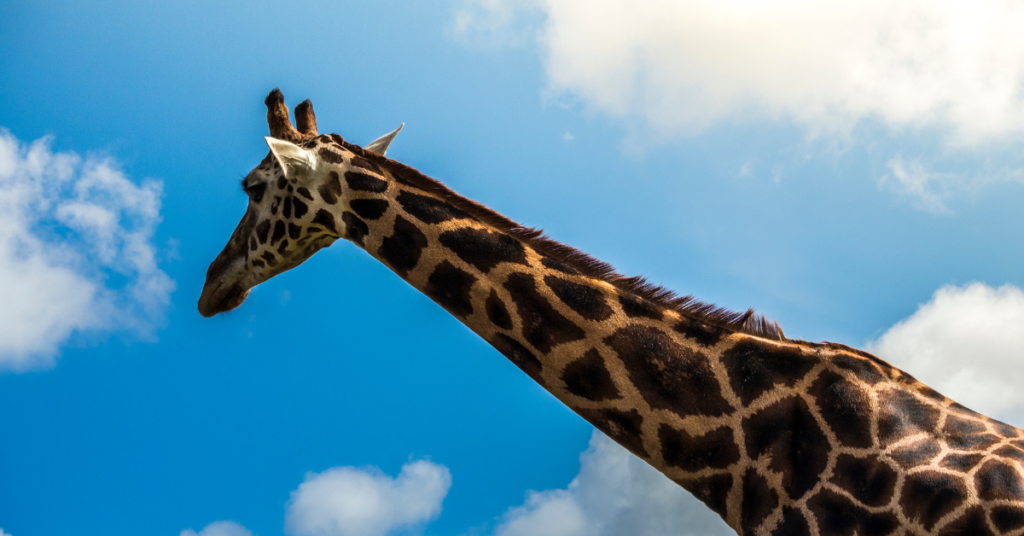Some of the theories why giraffes have long necks are protection from predation, increased vigilance and strength, increased surface area for thermoregulatory heat loss, males sexual dominance, and access to food. At giraffe height evolved in response to benefits conferred by foraging, height stratification was only true for the adult.
Access to food
Giraffes tended to forage at heights of 1.7 to 3.7 m. Greater Kudus were therefore in competition with female (and young) Giraffes. Other dietary studies have noted that Giraffes frequently feed well below their maximum foraging height . However, analysis of the food competition hypothesis suggests that a long neck confers at least some advantage when the lower leaves of trees were eaten by these shorter grazers.
Dominance
The long neck may have evolved in response to the sexual advantage it confers, using their necks and heads to gain sexual dominance. However, this ‘necks for sex’ theory was not supported by empirical data that showed that the morphological differences between the sexes are minimal and that any existing differences can be accounted for by the larger realized mass.
Looking at these two main competing hypotheses, the main challenge for the competing browser hypothesis is to explain why Giraffes have remained about 2 m taller than competing navigators for over a million years considering the costs involved, while the sexual selection hypothesis fails to account for the long neck off the male giraffe.
Predator Detection
It has been suggested that the long neck of the giraffe evolved because it helps to detect predators: giraffes have excellent eyesight and their auditory and olfactory senses are well developed. They can spot hazards and conspecifics from a greater distance than other savannah species and seem to stay indoor contact by sight at a distance of over a mile (especially outdoors) due to their height.
Avoidance of predators may also explain coat markings in giraffes, which could serve as camouflage for calves during the hiding stage, as calves are vulnerable to high rates of predation during the first few months of life. Conversely, predation risk does not appear to be significant when alone or accompanied by calves.
Increased vigilance and strength
Additionally, with the extension of the neck, there is also the lengthening of the limbs. The bones of the most distal limbs, especially the metapodials, but not the humerus or the femur, are extraordinarily elongated and slender for an animal of this size, suggesting that the increase in length must be compensated by an increase in strength. This increase in strength was facilitated by the high density of lower extremity bones so that approximately 80% of all skeletal calcium is found in load-bearing bones which are denser than other bones.
The giraffe skeleton contains three times more amounts calcium and phosphorus than that found in the African buffalo skeleton. This translates to a 1. 5- to 2-fold higher calcium requirement for Giraffes, with which they seem to cope effectively by selecting calcium-rich, dicotyledonous. Meeting phosphorus needs are less clear and seasonal phosphorus deficiency is a likely cause of some cases of observed osteophagia.

Erzsebet Frey (Eli Frey) is an ecologist and online entrepreneur with a Master of Science in Ecology from the University of Belgrade. Originally from Serbia, she has lived in Sri Lanka since 2017. Eli has worked internationally in countries like Oman, Brazil, Germany, and Sri Lanka. In 2018, she expanded into SEO and blogging, completing courses from UC Davis and Edinburgh. Eli has founded multiple websites focused on biology, ecology, environmental science, sustainable and simple living, and outdoor activities. She enjoys creating nature and simple living videos on YouTube and participates in speleology, diving, and hiking.
🌿 Explore the Wild Side!
Discover eBooks, guides, templates and stylish wildlife-themed T-shirts, notebooks, scrunchies, bandanas, and tote bags. Perfect for nature lovers and wildlife enthusiasts!
Visit My Shop →
